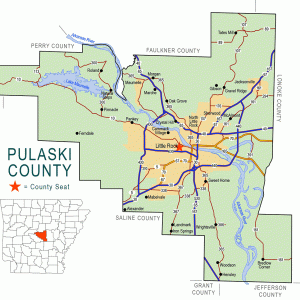calsfoundation@cals.org
Gibson (Pulaski County)
Gibson is an unincorporated community in northern Pulaski County, between Camp Joseph T. Robinson and the Sherwood (Pulaski County) neighborhood of Gravel Ridge. Within the boundaries of Gibson are the silver deposits from which North Little Rock (Pulaski County) derived its alternate name of Argenta (after the Latin word for silver).
After the territorial capital was moved from Arkansas Post (Arkansas County) to Little Rock (Pulaski County) in 1821, settlers began to acquire land around the growing city, including land north of the Arkansas River. Most of these settlers were farmers growing cotton or subsistence crops, and many used land grants from the War of 1812 to take possession of their land. Among the earliest to claim land in the future location of Gibson were William Beech in 1821, William Johnson in 1822, and John Stone in 1822.
The most famous new settler in the area was Benjamin Kellogg. Kellogg was born in New England (either Vermont or Massachusetts) around 1797 and moved to Little Rock shortly after the city was established. A blacksmith by trade, Kellogg is credited with creating the broadaxe used to construct the Chandler home in Little Rock. This structure was the first hewed-log house in Little Rock; all those built earlier were constructed of round poles. Kellogg first bought land in northern Pulaski County in 1834 and sometime later reported finding lead ore that had been unearthed by the tunneling activities of crayfish. Kellogg purchased more lots of land along the creek that now bears his name, but a mining corporation was formed that claimed to have leased mining rights to Kellogg’s land for ninety-nine years (Kellogg claimed that the lease was only to last five years). At least three mine shafts were dug, revealing small veins of silver, lead, zinc, and copper. Kellogg died in 1848, and most of the miners left the next year for the richer promises of California gold mining.
The mines were still being worked during the first years of the Civil War, although they had been abandoned before Major General Frederick Steele’s forces passed by on their way to Little Rock in 1863. The mines are described in the Goodspeed accounts of 1889 with descriptions of lead and copper ores and of attempts to locate gold. It appears, though, that the mines had already been long abandoned by the time those accounts were published. An effort to reopen the mines in 1925 produced 3,118 troy ounces of silver valued at $2,164, but that may be the last time mining was attempted in the area.
The origin of the name “Gibson” for the community is uncertain; it may have derived its name from the Gibson cemetery, which contains, among dozens of graves, those of Mattie Cordelia Gibson, who died in 1915, and of her husband John Calvin, who died in 1951 on his eighty-first birthday. Pulaski County Judge C. T. Coffman proposed to build a bridge across Kellogg Creek in 1905, but otherwise the area remained largely unnoticed and sparsely settled until after World War II. Establishment of the Little Rock Air Force Base in nearby Jacksonville (Pulaski County) brought about considerable construction of houses and businesses during the latter half of the twentieth century. The U.S. Census Bureau first reported a count of citizens of Gibson in 1990, when it found 4,288 people living there. The population had grown to 4,678 by 2000 but dropped to 3,543 by 2010.
In addition to houses, the community of Gibson has several businesses. Pine Valley Golf Course is in Gibson, as is Runyan First Baptist Church. The community is also home to Northwood Middle School, which is part of the Pulaski County Special School District. The population of Gibson is largely white, but according to the 2010 census, the community includes 478 African Americans and 167 Hispanics.
For additional information:
Sterling, Philip J. “A Brief History of Mining in Pulaski County, Arkansas.” Pulaski County Historical Review 8 (September 1960): 40–47.
Steven Teske
Butler Center for Arkansas Studies
 Pulaski County Map
Pulaski County Map 




Comments
No comments on this entry yet.